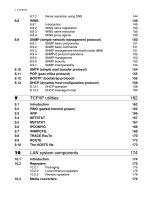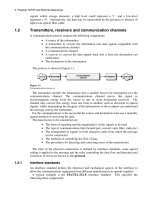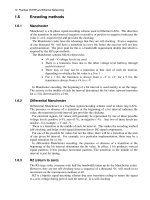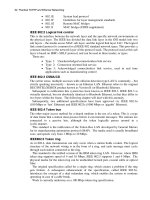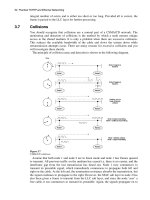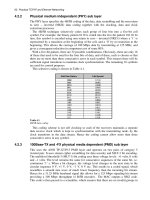Practical TCP/IP and Ethernet Networking- P3 ppsx
Bạn đang xem bản rút gọn của tài liệu. Xem và tải ngay bản đầy đủ của tài liệu tại đây (463.75 KB, 10 trang )
6XGIZOIGR:)6/6GTJ+ZNKXTKZ4KZ]UXQOTM
signals within storage elements; a high level could represent a ‘1’, and a low-level
represent a ‘0’. Alternatively, the data may be represented by the presence or absence of
light in an optical fiber cable.
:XGTYSOZZKXYXKIKO\KXYGTJIUSS[TOIGZOUTINGTTKRY
A communications process requires the following components:
• A source of the information
• A transmitter to convert the information into data signals compatible with
the communications channel
• A communications channel
• A receiver to convert the data signals back into a form the destination can
understand
• The destination of the information
This process is shown in Figure 1.1.
Figure 1.1
Communications process
The transmitter encodes the information into a suitable form to be transmitted over the
communications channel. The communications channel moves this signal as
electromagnetic energy from the source to one or more destination receivers. The
channel may convert this energy from one form to another, such as electrical to optical
signals, whilst maintaining the integrity of the information so the recipient can understand
the message sent by the transmitter.
For the communications to be successful the source and destination must use a mutually
agreed method of conveying the data.
The main factors to be considered are:
• The form of signaling and the magnitude(s) of the signals to be used
• The type of communications link (twisted pair, coaxial, optic fiber, radio etc)
• The arrangement of signals to form character codes from which the message
can be constructed
• The methods of controlling the flow of data
• The procedures for detecting and correcting errors in the transmission
The form of the physical connections is defined by interface standards, some agreed
coding is applied to the message and the rules controlling the data flow and detection and
correction of errors are known as the
protocol
.
/TZKXLGIKYZGTJGXJY
An interface standard defines the electrical and mechanical aspects of the interface to
allow the communications equipment from different manufacturers to operate together.
A typical example is the
EIA/TIA-232-E
interface standard. This specifies the
following three components:
/TZXUJ[IZOUTZUIUSS[TOIGZOUTY
•
Electrical signal characteristics
– defining the allowable voltage levels,
grounding characteristics etc
•
Mechanical characteristics
– defining the connector arrangements and pin
assignments
•
Functional description of the interchange circuits
– defining the function
of the various data, timing and control signals used at the interface
It should be emphasized that the interface standard only defines the electrical and
mechanical aspects of the interface between devices and does not cover how data is
transferred between them.
)UJOTM
A wide variety of codes have been used for communications purposes. Early telegraph
communications used Morse code with human operators as transmitter and receiver. The
Baudot code introduced a constant 5-bit code length for use with mechanical telegraph
transmitters and receivers. The commonly used codes for data communications today are
the
Extended Binary Coded Decimal Interchange Code
(EBCIDIC) and the
American
Standards Committee for Information Interchange
(ASCII).
6XUZUIURY
A protocol is essential for defining the common message format and procedures for
transferring data between all devices on the network. It includes the following important
features:
•
Initialization:
Initializes the protocol parameters and commences the data
transmission
•
Framing and synchronization:
Defines the start and end of the frame and
how the receiver can synchronize to the data stream
•
Flow control:
Ensures that the receiver is able to advise the transmitter to
regulate the data flow and ensure no data is lost.
•
Line control:
Used with half-duplex links to reverse the roles of transmitter
and receiver and begin transmission in the other direction.
•
Error control:
Provides techniques to check the accuracy of the received
data to identify transmission errors. These include Block Redundancy checks
and cyclic redundancy checks
•
Time out control:
Procedures for transmitters to retry or abort transmission
when acknowledgments are not received within agreed time limits
9USKIUSSUTR_[YKJIUSS[TOIGZOUTYVXUZUIURY
• Xmodem or Kermit for asynchronous file transmission
• Binary synchronous protocol (BSC), synchronous data link control (SDLC)
or high level data link control (HDLC) for synchronous transmissions
• Industrial protocols such as manufacturing automation protocol (MAP),
technical office protocol (TOP), Modbus, Data Highway Plus, HART,
Profibus, Foundation Fieldbus, etc
6XGIZOIGR:)6/6GTJ+ZNKXTKZ4KZ]UXQOTM
:_VKYULIUSS[TOIGZOUTINGTTKRY
'TGRUMIUSS[TOIGZOUTYINGTTKRY
An analog communications channel conveys analog signals that are changing
continuously in both frequency and amplitude. These signals are commonly used for
audio and video communication as illustrated in Figure 1.2 and Figure 1.3.
Figure 1.2
Analog signal
Figure 1.3
Digital signal
)USS[TOIGZOUTINGTTKRVXUVKXZOKY
9OMTGRGZZKT[GZOUT
As the signal travels along a communications channel its amplitude decreases as the
physical medium resists the flow of the electromagnetic energy. This effect is known as
signal attenuation. With electrical signaling some materials such as copper are very
efficient conductors of electrical energy. However, all conductors contain impurities that
/TZXUJ[IZOUTZUIUSS[TOIGZOUTY
resist the movement of the electrons that constitute the electric current. The resistance of
the conductors causes some of the electrical energy of the signal to be converted to heat
energy as the signal progresses along the cable resulting in a continuous decrease in the
electrical signal. The signal attenuation is measured in terms of signal loss per unit length
of the cable, typically dB/km.
Figure 1.4
Signal attenuation
To allow for attenuation, a limit is set for the maximum length of the communications
channel. This is to ensure that the attenuated signal arriving at the receiver is of sufficient
amplitude to be reliably detected and correctly interpreted. If the channel is longer than
this maximum length, amplifiers or repeaters must be used at intervals along the channel
to restore the signal to acceptable levels.
Figure 1.5
Signal repeaters
Signal attenuation increases as the frequency increases. This causes distortion to
practical signals containing a range of frequencies. This is illustrated in Figure 1.4 where
the rise-times of the attenuated signals progressively decrease as the signal travels
through the channel, caused by the greater attenuation of the high frequency components.
This problem can be overcome by the use of amplifiers that amplify the higher
frequencies by greater amounts.
6XGIZOIGR:)6/6GTJ+ZNKXTKZ4KZ]UXQOTM
)NGTTKRHGTJ]OJZN
The quantity of information a channel can convey over a given period is determined by its
ability to handle the rate of change of the signal, that is its frequency. An analog signal
varies between a minimum and maximum frequency and the difference between those
frequencies is the bandwidth of that signal. The bandwidth of an analog channel is the
difference between the highest and lowest frequencies that can be reliably received over
the channel. These frequencies are often those at which the signal has fallen to half the
power relative to the mid-band frequencies, referred to as 3 dB points. In which case the
bandwidth is known as the 3 dB bandwidth.
Figure 1.6
Channel bandwidth
Digital signals are made up of a large number of frequency components, but only those
within the bandwidth of the channel will be able to be received. It follows that the larger
the bandwidth of the channel, the higher the data transfer rate can be and more high
frequency components of the digital signal can be transported, and so a more accurate
reproduction of the transmitted signal can be received.
Figure 1.7
Effect of channel bandwidth on digital signal
/TZXUJ[IZOUTZUIUSS[TOIGZOUTY
The maximum data transfer rate (C) of the transmission channel can be determined
from its bandwidth, by use of the following formula derived by Shannon.
C
= 2
B
log
2
M
bps
Where
B = bandwidth in hertz and M levels are used for each signaling element.
In the special case where only two levels, ‘ON’ and ‘OFF’ are used (binary), M = 2 and
C = 2 B. As an example, the maximum data transfer rate for a PSTN channel of
bandwidth 3200 hertz carrying a binary signal would be 2 × 3200 = 6400 bps. The
achievable data transfer rate is reduced to ½ of 6400 because of the Nyquist rate. It is
further reduced in practical situations because of the presence of noise on the channel to
approximately 2400 bps unless some modulation system is used.
4UOYK
As the signals pass through a communications channel the atomic particles and molecules
in the transmission medium vibrate and emit random electromagnetic signals as noise.
The strength of the transmitted signal is normally large relative to the noise signal.
However, as the signal travels through the channel and is attenuated, its level can
approach that of the noise. When the wanted signal is not significantly higher than the
background noise, the receiver cannot separate the data from the noise and
communication errors occur.
An important parameter of the channel is the ratio of the power of the received signal
(S) to the power of the noise signal (N). The ratio S/N is called the signal to noise ratio,
which is normally expressed in decibels, abbreviated to dB.
S
/
N
= 10 log
10
(
S
/
N
) dB
A high signal to noise ratio means that the wanted signal power is high compared to the
noise level, resulting in good quality signal reception. The theoretical maximum data
transfer rate for a practical channel can be calculated using the Shannon-Hartley law,
which states:
C
=
B
log
2
(1+
S
/
N
) bps
Where
C = data rate in bps
B = bandwidth of the channel in hertz
S = signal power in watts and N is the noise power in watts
It can be seen from this formula that increasing the bandwidth or increasing the signal
to noise ratio will allow increases to the data rate, and that a relatively small increase in
bandwidth is equivalent to a much greater increase in signal to noise ratio.
Digital transmission channels make use of higher bandwidths and digital repeaters or
regenerators to regenerate the signals at regular intervals and maintain acceptable signal
to noise ratios. The degraded signals received at the regenerator are detected, then re-
timed and retransmitted as nearly perfect replicas of the original digital signals, as shown
in Figure 1.8. Provided the signal to noise ratios are maintained in each link, there is no
accumulated noise on the signal, even when transmitted thousands of kilometers.
6XGIZOIGR:)6/6GTJ+ZNKXTKZ4KZ]UXQOTM
Figure 1.8
Digital link
*GZGZXGTYSOYYOUTSUJKY
*OXKIZOUTULYOMTGRLRU]
9OSVRK^
A simplex channel is unidirectional and allows data to flow in one direction only, as
shown in Figure 1.9. Public radio broadcasting is an example of a simplex transmission.
The radio station transmits the broadcast program, but does not receive any signals back
from your radio receiver.
Figure 1.9
Simplex transmission
This has limited use for data transfer purposes, as we invariably require the flow of data
in both directions to control the transfer process, acknowledge data etc.
.GRLJ[VRK^
Half-duplex transmission allows us to provide simplex communication in both directions
over a single channel, as shown in Figure 1.10. Here the transmitter at station ‘A’ sends
data to a receiver at station ‘B’. A line turnaround procedure takes place whenever
transmission is required in the opposite direction. The station ‘B’ transmitter is then
enabled and communicates with the receiver at station ‘A’. The delay in the line
turnaround procedures reduces the available data throughput of the communications
channel.
/TZXUJ[IZOUTZUIUSS[TOIGZOUTY
Figure 1.10
Half-duplex transmission
,[RRJ[VRK^
A full-duplex channel gives simultaneous communications in both directions, as shown in
Figure 1.11.
Figure 1.11
Full-duplex transmission
9_TINXUTO`GZOUTULJOMOZGRJGZGYOMTGRY
Data communications depends on the timing of the signal generation and reception being
kept correct throughout the message transmission. The receiver needs to look at the
incoming data at the correct instants before determining whether a ‘1’ or ‘0’ was
transmitted. The process of selecting and maintaining these sampling times is called
synchronization.
In order to synchronize their transmissions, the transmitting and receiving devices need
to agree on the length of the code elements to be used, known as the bit time. The
receiver needs to extract the transmitted clock signal encoded into the received data
stream. By synchronizing the bit time of the receiver’s clock with that encoded by the
sender, the receiver is able to determine the right times to detect the data transitions in the
message and correctly receive the message. The devices at both ends of a digital channel
can synchronize themselves using either asynchronous or synchronous transmission as
outlined below.
6XGIZOIGR:)6/6GTJ+ZNKXTKZ4KZ]UXQOTM
'Y_TINXUTU[YZXGTYSOYYOUT
Here the transmitter and receiver operate independently, and exchange a synchronizing
pattern at the start of each message code element (frame). There is no fixed relationship
between one message frame and the next, such as a computer keyboard input with
potentially long random pauses between keystrokes.
Figure 1.12
Asynchronous data transmission
At the receiver the channel is sampled at a high rate, typically in excess of 16 times the
bit rate of the data channel, to accurately determine the centers of the synchronizing
pattern (start bit) and its duration (bit time).
Figure 1.13
Clock estimation at receiver
The data bits are then determined by the receiver sampling the channel at intervals
corresponding to the centers of each transmitted bit. These are estimated by delaying
multiples of the bit time from the centers of the start bit. For an eight-bit serial
transmission, this sampling is repeated for each of the eight data bits then a final sample
is made during the ninth time interval. This sample is to identify the stop bit and confirm
that the synchronization has been maintained to the end of the message frame. Figure
1.14 illustrates the asynchronous data reception process.
/TZXUJ[IZOUTZUIUSS[TOIGZOUTY
Figure 1.14
Asynchronous data reception
9_TINXUTU[YZXGTYSOYYOUT
The receiver here is initially synchronized to the transmitter then maintains this
synchronization throughout the continuous transmission. This is achieved by special data
coding schemes, such as Manchester encoding, which ensure that the transmitted clock is
continuously encoded into the transmitted data stream. This enables the synchronization
to be maintained at any receiver right to the last bit of the message, which could be as
large as 4500 bytes (36 000 bits). This allows larger frames of data to be efficiently
transferred at higher data rates. The synchronous system packs many characters together
and sends them as a continuous stream, called a block. For each transmission block there
is a preamble, containing the start delimiter for initial synchronization purposes and
information about the block, and a post-amble, to give error checking, etc. An example of
a synchronous transmission block is shown in Figure 1.15. Understandably all high-
speed data transfer systems utilize synchronous transmission systems to achieve fast,
accurate transfers of large blocks of data.
Figure 1.15
Synchronous transmission block

